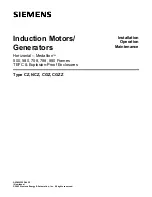
- 12 -
Operation
Trouble Shooting
TROUBLE POSSIBLE
CAUSES
CORRECTION
Open stator windings.
Disconnect motor from load. Check idle amps
for balance in all three phases. Check stator
resistance in all three phases for balance.
Air Recirculation.
Check air intake and exhaust for obstructions.
Check air inlet temperature.
Over voltage/under voltage.
Check voltage and compare to rating plate.
Ground.
Locate with test lamp or insulation tester and
repair.
Improper electrical connections.
Recheck electrical connections.
Heat exchanger tubes blocked.
Clean tubes, if so equipped.
Motor overheating
(continued…)
Loose heat exchanger tubes.
If so equipped, Roll tubes to expand tube
inside diameter using proper expansion tool.
Fine dust under coupling
having rubber buffers or
pins.
Misalignment.
Realign motor and driven equipment.
Inspect coupling.
Oil level too high or low (sleeve bearing).
Correct oil level. See
Maintenance
section of
this instruction book to determine proper oil
level.
Misalignment.
Realign motor and driven equipment.
Excessive tension in belt drive.
Reduce tension to point of adequacy.
Excessive end thrust.
Reduce thrust. Recheck mounting and
alignment.
Too much grease (ball or roller bearing).
Relieve supply to point set by manufacturer.
Bearing overheating.
Sticking oil ring (sleeve bearing).
Clean, repair, or replace. Recheck mounting.
Parts not sealed properly.
Seal pipe plugs and connections.
Seal bearing housing split line.
Seal oil seal joint.
Oil leakage or excessive
oil usage.
Clogged oil return holes in oil seals.
Dismantle and clean oil seals.
Excessive oil level
fluctuation.
High pressure or vacuum in bearing cavity.
Measure pressure or vacuum using
manometer (See “Cavity Pressures” under
Bearings
).
Check atmospheric vents for obstructions.
Check oil seal gap for uniformity.
DANGER
Hazardous
voltage.
Will cause death, serious injury,
electrocution or property damage.
Disconnect all power before working on
this equipment.














































